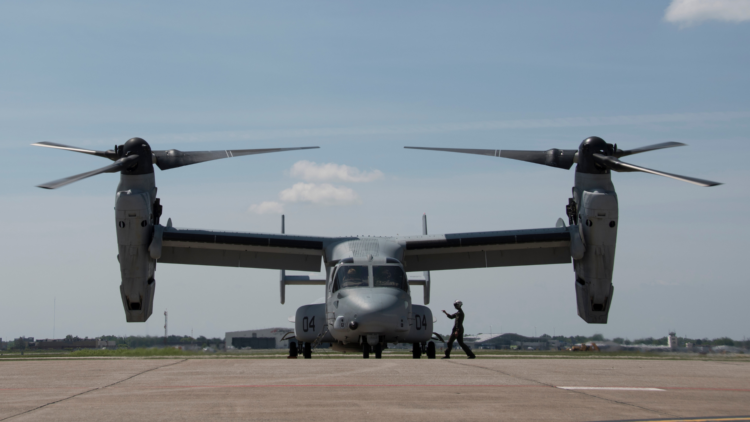The nearly 400 V-22 Ospreys, a versatile tiltrotor aircraft prized for its ability to take off and land vertically, will be sidelined from their full range of duties until at least mid-2025. This comes after a series of deadly crashes in 2022 and 2023 raised alarm bells about the aircraft’s safety.
Vice Admiral Carl Chebi, head of the US Naval Air Systems Command (NAVAIR), announced the limitations during a tense hearing before the House Committee on Oversight and Accountability on Wednesday, June 12.
A String of Tragedies
Since its introduction in 2007, the V-22 Osprey has boasted an impressive repertoire. It can take off and land vertically like a helicopter, offering unmatched flexibility for troop deployment and battlefield access.
At the same time, it possesses the speed and range of a fixed-wing aircraft, making it a valuable asset for long-distance transport and rapid response missions.
However, this versatility comes at a cost.
During the subpanel hearing, Chebi emphasized the safety concerns over the Osprey, stating, “I will not certify the V-22 to return to unrestricted flight operations until I am satisfied that we have sufficiently addressed the issues that may affect the safety of the aircraft.”
In just two years, Osprey’s fatal crashes had claimed the lives of 20 service members.
The most recent incident, an Air Force Osprey crash off the coast of Japan in November 2023, killed eight. This tragedy prompted a three-month grounding of all Ospreys before they were allowed back in the air with restricted flight envelopes, limiting their range and capabilities.
Congressional Scrutiny and Mounting Frustration
The House committee launched its own investigation into the Osprey program in December 2023.
Lawmakers expressed frustration over limited access to safety information, particularly wear and tear data on the Osprey’s propeller rotor gearbox, a component suspected to be a factor in the Japan crash.
Representative Stephen Lynch (D-Mass.) voiced the committee’s concern, stating:
Already have an account? Sign In
Two ways to continue to read this article.
Subscribe
$1.99
every 4 weeks
- Unlimited access to all articles
- Support independent journalism
- Ad-free reading experience
Subscribe Now
Recurring Monthly. Cancel Anytime.
“The repeated drumbeat of fatalities is totally unacceptable. What do you think the consequences will be if we have another V-22 (Osprey) go down, and we lose more brave Marines or airmen […] ? Your whole program’s done. It’s done.”
Yesterday the Oversight Subcommittee on National Security held a hearing on the Department of Defense’s V-22 Osprey Aircraft Program, which has resulted in the deaths of over 50 U.S. Marines and Airmen during routine training exercises. pic.twitter.com/O2kyNef9Av
— Rep. Stephen Lynch (@RepStephenLynch) June 13, 2024
Safety Issues Under the Microscope
NAVAIR is under immense pressure to address these concerns.
Investigations are ongoing, with a particular focus on a persistent clutch failure identified as a contributing factor in a June 2022 crash that killed five Marines in California.
The families of the fallen service members have filed lawsuits against the aircraft’s manufacturers, alleging design and manufacturing flaws.
The Future of the Osprey
The potential termination of the entire V-22 program hangs heavy in the air.
Several lawmakers, including Rep. Lynch, have warned that another fatal crash could be the program’s death knell.
The next six to nine months are crucial for NAVAIR.
Completing a thorough safety assessment and addressing lingering issues will determine whether the Osprey can regain its full flight capability and maintain its place as a vital military asset.
Watch the live coverage of the Wednesday House hearing below.
The grounding of the Osprey also compels the military to consider alternative solutions. While the Osprey’s versatility offers undeniable advantages, the potential safety risks cannot be ignored. Investing in developing safer, next-generation tiltrotor aircraft might be a prudent long-term strategy.
Ultimately, the V-22 Osprey finds itself at a crossroads. The path forward requires a renewed commitment to safety, transparency with lawmakers, and potentially reevaluating the program’s future within the US military arsenal. The next chapter in the Osprey story will be written in the coming months, and the outcome will significantly impact the capabilities and safety of the US military for years to come.











COMMENTS
You must become a subscriber or login to view or post comments on this article.